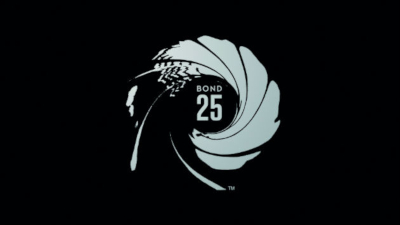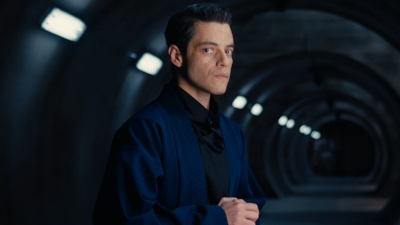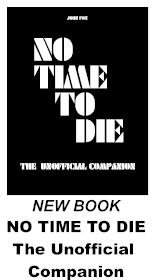|
No Time To Die - The Production Begins

The
first reported day of shooting on Bond 25 took place in Jamaica. Daniel
Craig was seen shooting some scenes with Jeffrey Wright - who was back
as Felix. Craig and his stunt double Jean-Charles Rousseau were
required to drive a battered Land Rover in some street market
sequences. Lashana Lynch also shot some scenes during the Jamaica
shoot. While the crew was in Jamaica they also shot some scenes that
doubled for Cuba. These days it is impossible to make a film in secret
and so there were copious photographs and reports in the media of
Daniel Craig (in Barbour x Engineered Garments Graham Jacket and
Vuarnet Legend 06 sunglasses) shooting his first scenes. MGM and EON
were happy for for these early reports because it was good publicity
for the film and let fans and audiences know that - FINALLY - a new
Bond film was now in production.Craig
was wearing an Omega Seamaster watch in the first leaked set reports.
Bond was seen driving a blue Land Rover Series III in Port Antonio
(where the producers and cast stayed during the shoot). This Land Rover
had been seen in the Bond series before when it featured in the
pre-title sequence on Gibraltar for The Living Daylights. Barbara
Broccoli and Michael G Wilson gave an interview to the local newspaper
while they were in Port Antonio. They said that shooting in the West
Indies was a wonderful experience. It was great to finally get underway
- although Bond 25 had already shot some scenes in Norway. It was a
shrewd ploy to shoot some scenes in Norway before the official press
conference. This had made it easier to avoid too much publicity and
potential spoilers in Norway. Daniel
Craig said that Bond 25 went through four scripts before it started
shooting. Baz Bamigboye, known for some fairly accurate Bond scoops in
the Daily Mail, reported that even though shooting had begun, the
script was still a work in progress and that everyone, including Daniel
Craig, was working on the screenplay. The Daily Mail's source described
Bond 25 as a 'well polished s***show'. Bond films (and films into
general) going into production with the script still in flux is by no
means new though. The 1997 film Tomorrow Never Dies had its entire
script jettisoned as it entered production. Jonathan Pryce, who played
the villain in that film, complained that he was suddenly given a new
script that bore little resemblance to the one he had signed on for.
Judi Dench also complained of having to learn an entirely new script at
the last minute on Tomorrow Never Dies. 2008's Quantum of Solace, which
was affected by a writer's strike, also began production with a script
that wasn't completely finished. Two
weeks into May 2019, the Daily Mirror reported that there was tension
between Daniel Craig and Cary Fukunaga. The vague evidence for this
were some blurry photographs of the pair in conversation that seemed to
feature some shoulder shrugging and finger pointing. At this time it
was also reported that Daniel Craig had injured his ankle and flown to
New York to have x-rays. He would be out of action for a while -
leading to fresh speculation on whether this would delay the film
again. Craig was shooting a dock scene when the injury occurred. This
marked the second time in a row that Craig had injured himself early on
in a Bond film. No wonder his wife was apparently fed-up with him
making Bond films and going home all battered and bruised. Injuries on
films like this were nothing new. Pierce Brosnan was injured sprinting
on the set of Die Another Day and Tom Cruise broke his ankle shooting a
rooftop stunt for Mission Impossible: Fallout. You can't wrap actors up
in cotton wool on an expensive action film.Making
a Bond film represents a fairly unique physical and mental challenge
for an actor. Production lasts about six months and as James Bond is
obviously going to be in virtually every scene you can't expect to get
too many days off. Factor in the stunts, fight scenes, and generally
getting battered and smashed around and you can see why Daniel Craig
came to enjoy making a new Bond film about as much as a trip to the
dentist. He had two teeth knocked out making Casino Royale, suffered a
bad leg injury making Spectre, and now he'd busted his ankle on Bond 25.Craig
was 51 when Bond 25 finished shooting. Only Roger Moore had been older
while making an EON Bond film. Pierce Brosnan was 49 when he made his
last film. Timothy Dalton was 44. Sean Connery was 40 when he shot his
'official' swansong Diamonds Are Forever. George Lazenby was 29 when he
made his one and only Bond film. While Daniel Craig had never exactly
relied on youthful boyish good looks (Craig was one of those people who
looked mature even when he was young) and didn't ever seem to change
much facially, his body was another matter altogether. This was the
main reason why he had been reluctant to sign up to Bond 25 in the
first place. He wasn't sure his body could take the strain. Even when
shooting ends on a Bond film the Bond actor is then required to hit the
chat show circuit, do endless magazine interviews, attend premieres and
press conferences, and shoot commercials. The promotional side of
playing James Bond was something that Daniel Craig (who is a very
private person) would not miss in the slightest. Despite
the concern, Craig was soon sighted back at Pinewood Studios and EON
were quick to stress there would be no delay to the film. They simply
had to shoot whatever scenes they could around the lead actor while
Craig was injured so that the production did not get behind schedule.
It was reported that Craig would require about two weeks of
rehabilitation. The press reported that he had been operated on by the
doctor who recently treated England football captain Harry Kane. Craig
was seen with a cast on his foot at this time but images of him in the
gym were soon released to signal his imminent return to action. For any
medical buff eager to know more about the injury - Craig had an ankle
ligament operation on his left ankle and suffered two ACL tears in his
knees. The Sun's 'source' described Craig as a medical miracle man for
fighting back from injuries that would have wrecked the career of world
class athletes. Cary Fukunaga's main concern at this time was whether
or not his leading man would actually be able to run in the film.If
anywhere can be called the physical home of James Bond it is Pinewood
Studios. Pinewood is a film and television studio located in the
village of Iver Heath in Buckinghamshire. 'The studio opened on 30
September 1936,' wrote The Guardian, 'with owners Sir Charles Boot and
J Arthur Rank inspired by Hollywood to create a thriving British film
industry, a desire that led to a series of mergers with other studios
over the years - the first in 1938, when Pinewood took over Alexander
Korda's Denham Studios. Pinewood quickly established itself as a
location for great British films. The Red Shoes, starring Moira
Shearer, was one of two Powell and Pressburger films to be shot there
(Black Narcissus was the other). A year later, the first Carry On film,
Carry On Sergeant, was filmed at the studio. It marked the start of 20
years of Carry On filming at Pinewood. Pinewood's greatest association,
however, is with the James Bond franchise. The first film, Dr No, was
shot there in 1962, and despite fires destroying sets in 1984 and 2006,
Bond films have continued to be filmed at the studio. The Bond stage
was rebuilt in 1985, the year before Pinewood's 50th birthday, and
renamed the Albert R. Broccoli Bond stage in honour of the 007
producer.'The news that Bond 25
was back shooting at Pinewood was like a historic dockyard hearing that
the biggest ship in the fleet was moored there again. It wouldn't quite
be the same without some shooting at Pinewood. There was trouble at
Pinewood though in June when a Peeping Tom was discovered. A convicted
sex offender (working as a maintenance man on Bond 25) planted a spy
camera in the ladies’ toilets of the studios. He was later tried at
Aylesbury Crown Court and given 16 months in prison. It
was reported in the media that Bond 25 would have an 'intimacy' coach
for any love scenes. This was not officially confirmed by anyone
though. Cary Fukunaga continued to do interviews at this time and said
he was working 120% on the script to knock it into shape. The Bond
production crews, like two allied army groups fighting on different
fronts, were now simultaneously in Norway and back at Pinewood. The
Norway scenes that had been shot so far were rumoured to be part of a
pre-credit sequence featuring a young Dr Madeleine Swann. As of yet,
Lea Seydoux had not shot anything for Bond 25. She was still busy on
other films.There was a lot of
speculation that Madeleine Swann was going to be killed off early in
Bond 25 - even though it was clear by now that this film wasn't (as had
been feared) planning to reheat OHMSS and serve that up to fans again
in a different guise. The speculation that Madeleine was going to take
a very early bath in the story was unrealistic and wide of the mark. It
appeared unlikely they would go to all the trouble of hiring Seydoux
(who is not exactly short of work) again and then kill her character
off early. Her role in Bond 25 was going to be pivotal and important.
The gamble of course was that Bond 25 was investing a lot in a
character (Madeleine) and relationship (between Bond and Madeleine in
Spectre) that most people had probably forgotten about already.Bond
fans on forums were talking about this stuff because they knew all the
films by heart and love to speculate on all the story intricacies but
casual audiences (who were expected to make up the majority of the
box-office takings), unless they had recently rewatched Spectre, were
liable to walk into Bond 25 without the faintest idea who Madeleine
Swann was or why she was deemed to be so important to Bond. This, as
Cary Fukunaga was well aware, was going to require some delicate
exposition that had to be informative but not clumsy. The Daniel Craig
era has what you can only describe as an awkward chronology in that
Craig's Bond seemed to go from green agent to world weary veteran in
the space of about one film. The Craig era seems curiously light on
Bond just being an agent undertaking missions. It feels like a chunk of
his career is missing. The only
previous Bond films that deviated from the formula of Bond simply being
a super agent in favour of a more 'personal' type of story were OHMSS
and Licence To Kill. In the former Bond got married and in the latter
he went rogue to avenge an attack on Felix Leiter. Bond films had
brought back characters before (like Blofeld and Jaws) but they'd never
attempted an ongoing continuity before in the way that the Daniel Craig
films did. Licence To Kill makes no reference to The Living Daylights.
There is no major ongoing thread in the Brosnan films. The Roger Moore
and Sean Connery films are episodic. The one film that cried out for a
direct continuation, OHMSS, did not get one. OHMSS ends with the death
of Bond's wife. However, in the next film, Diamonds Are Forever, Sean
Connery was back in place of George Lazenby and Bond's 'revenge' on
Blofeld for the death of his wife is confined to the pre-title
sequence. It is not even fully established though that Connery's Bond
is the same Bond who went through the events of OHMSS. Never
before in the history of the franchise had the tenure of an actor
attempted to tell one long story in the way that the Craig films did.
Bond 25 was an attempt to thread all the Craig films together and give
them some sort of definitive conclusion. If Cary Fukunaga considered
this to be a hindrance to writing and directing Bond 25 it wasn't
something he ever complained about. The opposite seemed to be the case.
Fukunaga appeared to enjoy the fact that he had to pick up the threads
of a story seeded in the previous films. The question of whether or not
this experiment in continuity (if at times a vague continuity) through
the Craig films was successful is a matter of personal opinion. It was
fine for a Bond marathon but more casual viewers could be forgiven for
not having the faintest idea who Mr White was or barely remembering
that Blofeld was in the last film.Making
the Daniel Craig films connected (as opposed to traditional stand-alone
adventures) was not really something that was planned or mapped out
from the start. It was decided after the positive critical reception to
Casino Royale the next film (Quantum of Solace) would be a direct
continuation and reference its predecessor. The producers felt a lot of
goodwill after the reception to Casino Royale and so (understandably
perhaps) chose to make the next Bond film connected to its predecessor
in a way that the Bond franchise had never really attempted before.
Michael G Wilson, in interviews for Quantum of Solace, constantly
reminded audiences that this film was a direct continuation to Casino
Royale. His subtext was obvious. If you loved Casino Royale you'll love
this one. Sadly though, things weren't quite that simple. Quantum of
Solace was affected by a writer's strike and something of a mess
(though no doubt the film has its defenders). The
fact that Quantum of Solace referenced the previous film was something
that would become a staple through the Craig era. All of the Craig
films would be connected - in a fashion. One of the awkward things
about Quantum of Solace was that it created a crime syndicate known as
the Quantum Organisation to essentially act as a replacement for
SPECTRE. SPECTRE and Blofeld were unavailable to EON for many years
thanks to Kevin McClory. The Quantum Organisation then became redundant
two films later when SPECTRE and Blofeld returned to the series. The
Quantum Organisation was a clumsy adjunct to the title Quantum of
Solace - a genuine Fleming title that shouldn't have had to justify
itself. That was all in the past now though. Bond 25 would be the last
chapter in this experimental era and Bond 25 would, to get the most out
of the experience, require some knowledge and perhaps even an emotional
investment in what had gone before. 
It's
probably not completely accurate to say that the Bond films had never
been connected before the Daniel Craig era. The Connery Bonds slowly
develop Blofeld until he is revealed. Lazenby's Bond, upon his apparent
resignation from MI6, is reminded of past (Connery) adventures through
items in his office. The title sequence for On Her Majesty's Secret
Service also connects to the past by showing us clips of characters
from the Connery films. The intention is to assure us that while the
Bond actor has changed this is still the same character. Even the Roger
Moore films have some modest connective tissue when Jaws returns in
Moonraker (as a consequence of the character proving to be so popular
in The Spy Who Loved Me). The Craig era though was the first time the
Bond series had attempted anything other than a very vague continuity.
The Craig era relies on audiences to remember more about the previous
films than you ever had to do in the past.Rami
Malek suggested in a June interview that he had already been to Norway
to shoot a few bits and pieces for Bond. Malek said Cary Fukunaga was
in Norway too when he was there. Leaked photos revealed Safin wearing a
Phantom of the Opera style mask. Malek said this mask was important to
the character. "We didn’t pick a mask off a wall willy-nilly. We had to
think extremely specifically as to what would make the most sense. If
it doesn’t make sense to the story and to the character, then arguably
it loses impact." Cary Fukunaga said he drew on some Japanese
aesthetics to create Safin's look and background. Some
of the Norway sequences were being directed by Alexander Witt for the
2nd unit. A second unit director will typically shoot establishing
location shots and some action sequences when the director is busy
working with actors in the studio. Malek was shuttling back and forth
while he completed his obligations to the television show Mr Robot.
This was exhausting but he found the excitement and energy of being
part of a Bond production invigorating and very rewarding. Cary
Fukunaga, in interviews for Bond 25, talked about how he had an idea
that the end of 2015's Spectre all took place in Bond's head while he
was being tortured by Blofeld in that chair. The end of Spectre could
be a fever dream and Bond could wake to find himself still in the
chair. This would be like the classic 1890 short story An Occurrence at
Owl Creek Bridge by Ambrose Bierce. It's hard to know if Fukunaga was
joking (he probably was) but this was clearly an idea too far. You
can't imagine that Sam Mendes would have been too thrilled to see the
last act of Spectre written off as a bad dream. Fukunaga was not alone
in apparently finding Bond's all too easy escape from Blofeld in
Spectre to be oddly strange and dreamlike. It was one of the many
elements in Spectre that didn't quite make sense.Ben
Whishaw did an interview in the middle of June in which he said he was
due to start shooting his scenes for Bond 25 in two weeks but he still
hadn't seen a script. Whishaw, with some dry understatement, described
this as a 'bit alarming'. The newspapers also reported that, because of
scheduling commitments, Rami Malik and Daniel Craig might not be able
to actually shoot any scenes together. Well, look on the bright side,
suggested a few wits, you never saw Captain Kirk and Khan together in
Star Trek II and that turned out ok in the end. Malek said that the
stories about him not being able to shoot 'key' scenes in person with
Daniel Craig because of scheduling problems were completely bogus and
not true at. "The key scenes is something that was fabricated. But the
thing is, Daniel was injured, so they are shooting what they can. I
talked to Cary yesterday and the schedule has been altered. I know
that. But with a franchise like this, I think they have it together.
They have it figured out by now."In
June, a Bond 25 Behind-The-Scenes Featurette was released. This was a
short promo that featured some behind the scenes glimpses of the film
in production. The promo concentrated on the West Indian parts of the
shoot. A happy and relaxed looking Daniel Craig was seen laughing a
couple of times in the featurette - just to counter tabloid stories
that he was a miserable so and so who didn't even want to be here. The
aim of the promo was obviously to counter some of the mischief and
negativity in the media. The message from EON was that Bond 25 was
underway, it was all going fine, and everyone was happy and getting
along with one another. While it was difficult to discern too much from
such a short look at the film, there did seem to be an impressive
amount of colour in the shots that we saw. It would be an impressive
looking film if this promo was anything to go by.Set
visits to Bond 25 at Pinewood around this time revealed a lot of toxin
vial props - which led to the obvious conclusion that biological or
chemical warfare or terrorism featured in the plot. There was a mishap
on the set in June when a controlled explosion damaged the 007 Stage at
Pinewood Studios and left a crew member with minor injuries. The stunt
was for a scene where a fireball rips through a laboratory. The
resulting explosion damaged part of the roof of the 007 stage and
blasted off five huge panels from the outside of the building. The
British Health and Safety Executive, according to press reports,
launched an investigation and gave the Bond 'bosses' a telling off. The
Sun newspaper managed to get some photographs taken inside the sound
stage as part of their story. The photographs merely seemed to show
some scaffolding though. There wasn't much evidence of the laboratory
set. The Sun told its readers
that there had been three loud deafening bangs and one crew member had
almost been crushed by debris. It was 'utter chaos' The Sun reported
via the usual unverified 'insider'. The Daily Mail went even further
and said that Daniel Craig had said 'this isn't going to blow me up is
it?' prior to the accident. Bond fans could rest easy though. Daniel
Craig had not been blown up on the set of Bond 25 like Wile E. Coyote
in a Road Runner cartoon. The newspaper reports were inconsistent and
didn't really seem to know what had actually happened in the studio. In
the end no official investigation was launched by the authorities -
although a number of fire engines and ambulances had rushed to the
studio after the explosion. EON nearly blowing up the 007 sound stage
at Pinewood led to more idle newspaper speculation over whether or not
the production might be cursed. These short memories are illustrated by
the fact that MOST Bond productions (and film productions in general)
are like this anyway. Meanwhile,
it was reported that Phoebe Waller-Bridge had finished her work on the
Bond 25 screenplay and was no longer required for any rewrites. A lot
of shooting was done in London in the back end of June 2019. Whitehall
and Hammersmith were among the locations. Daniel Craig and Ralph
Fiennes were seen outside the Rutland Arms in Hammersmith shooting a
scene where Bond has a secret meeting with M. Rory Kinnear was also
seen on the set. A still released by EON showed Daniel Craig getting
out of an Aston Martin V8. These images confirmed that Bond would be
wearing Tom Ford suits in the film. He also had a pair of Barton
Perreira Joe sunglasses. The eagle-eyed would have spotted that Bond
had a Benson & Clegg Plain Slim Rhodium Tie Slide. Aston
Martin confirmed that the DB5, DBS Superleggera, and Valhalla models
would feature in the film. Daniel Craig had clearly recovered well
enough from his busted ankle to get back into the swing of things. He
didn't really have much choice in the matter. They could hardly finish
Bond 25 without Craig. As before, Daniel Craig would have to ignore the
pain and keep going until the film was in the can. After four Bond
films he was starting to get used to it.* The above article is an excerpt from the book No Time to Die - The Unofficial Companion.Buy No Time to Die - The Unofficial Companion.
© 2021
Alternative 007
|



|





